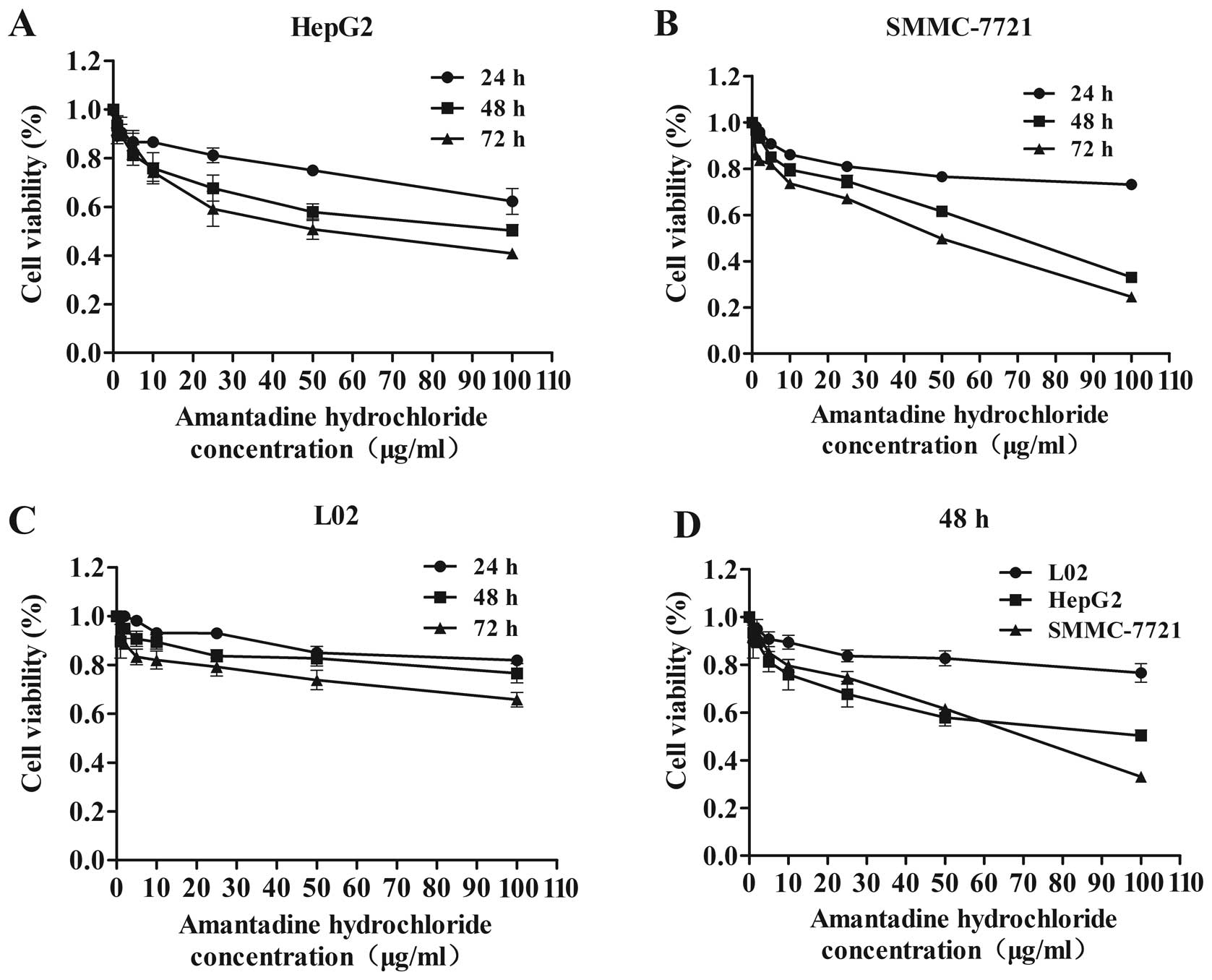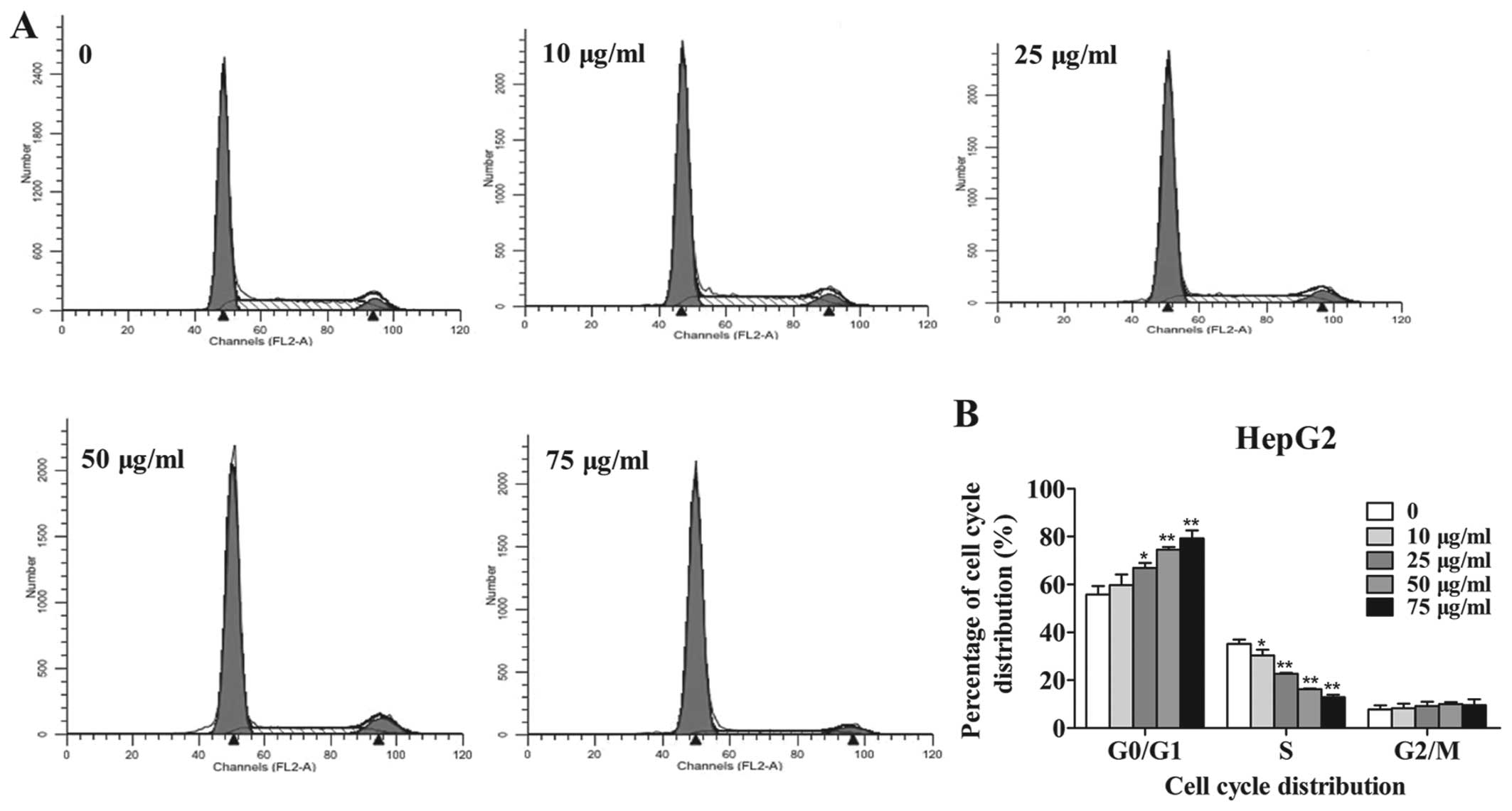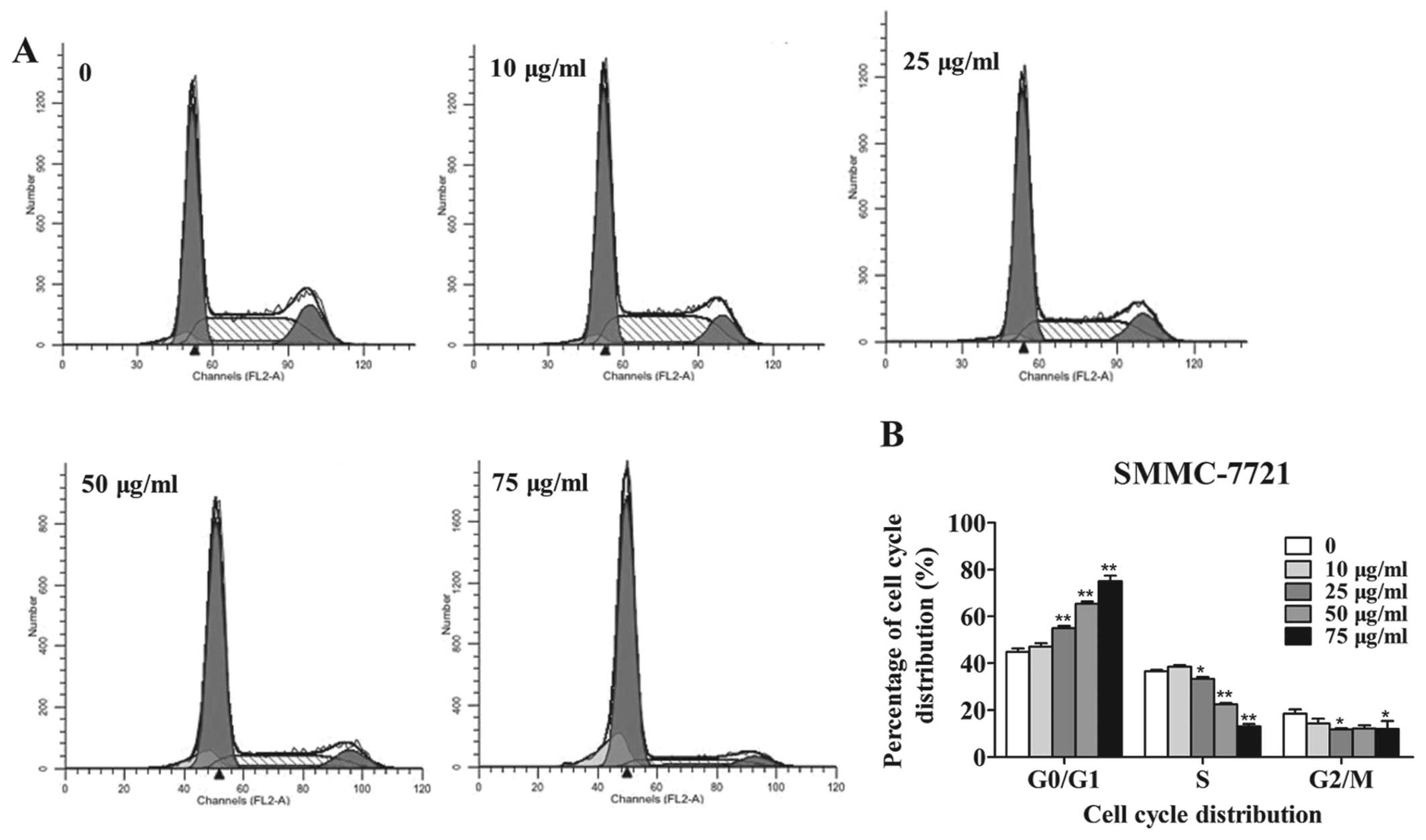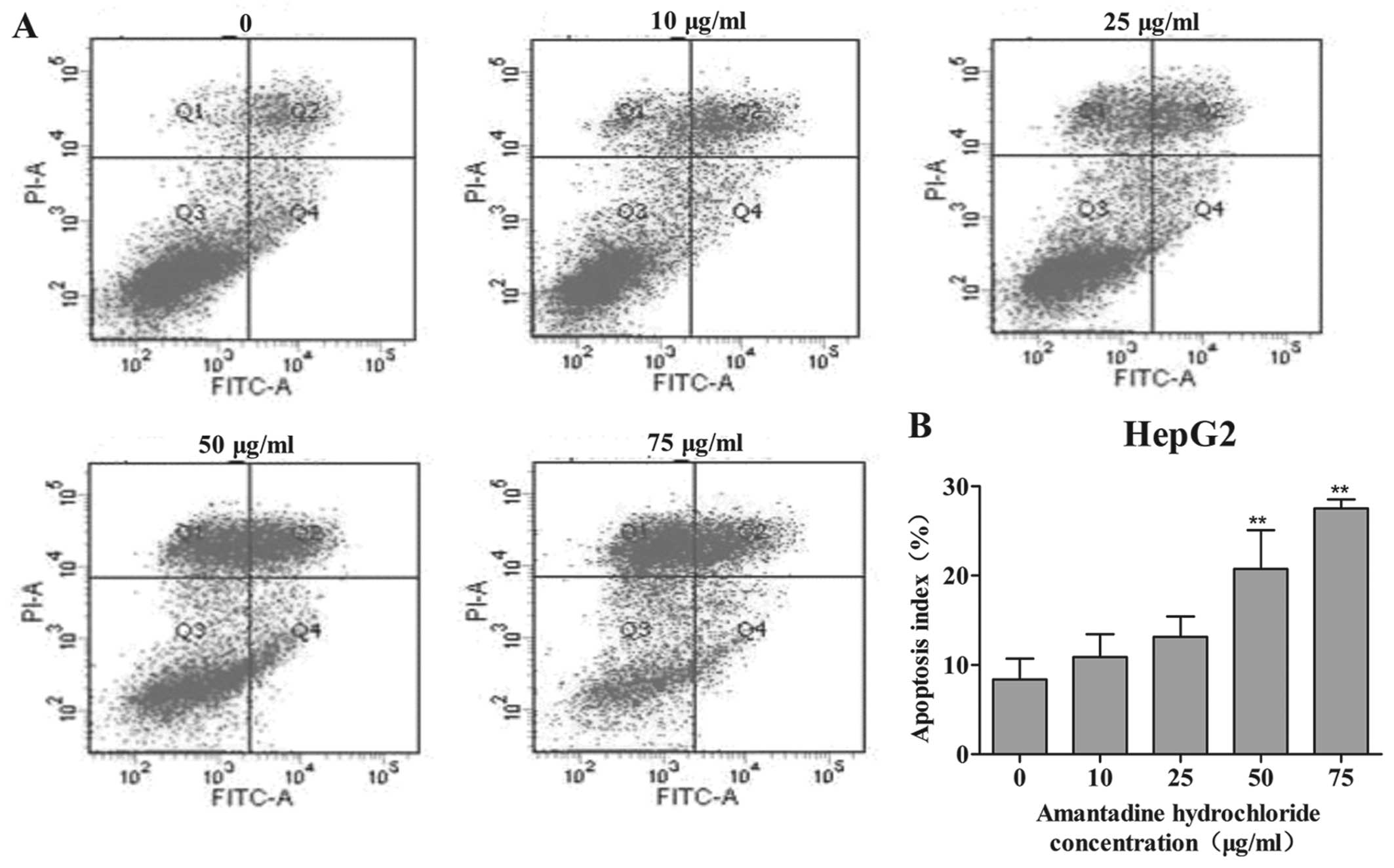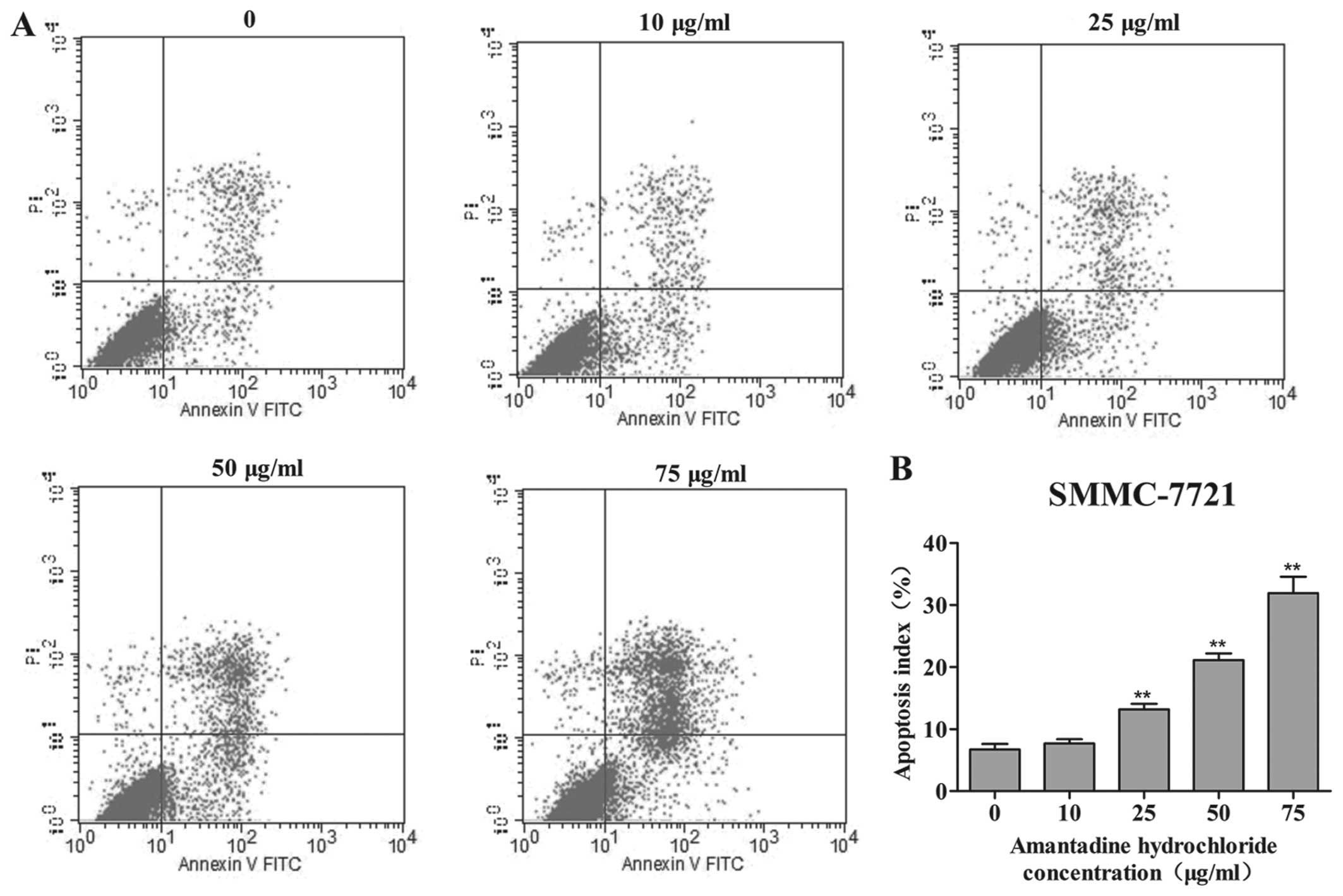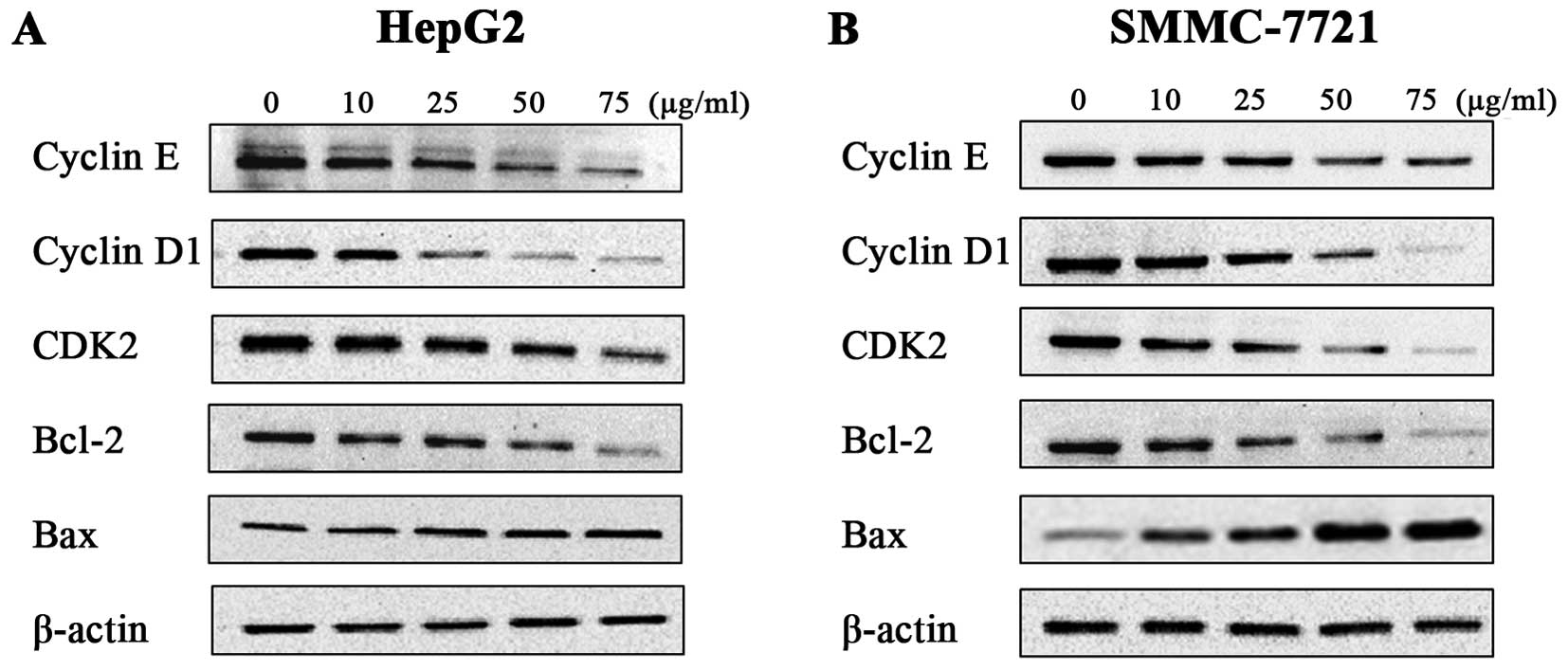Amantadine inhibits cellular proliferation and induces the apoptosis of hepatocellular cancer cells in vitro
- Authors:
- Published online on: July 20, 2015 https://doi.org/10.3892/ijmm.2015.2289
- Pages: 904-910
Abstract
Introduction
Hepatocellular carcinoma (HCC) is the sixth most widespread human cancer worldwide and the third most frequent cause of cancer-related mortality (1). HCC largely stems from hepatitis B viral (HBV) and hepatitis C viral (HCV) infections, together with other risk factors, such as aflatoxin, cirrhosis, alcohol consumption, non-alcoholic fatty liver disease, diabetes and tobacco. Considerable evidence has shown that the incidence of HCC in association with viral infection has increased in recent years. Among the viral infections, HCV was attributed to ~33% of total liver cancer studies in developing countries and ~20% of cancers reported in developed countries (2–5). Surgical therapies, such as hepatectomy and liver transplantation, are only effective for early stage HCC, and systemic chemotherapy remains the main approach for the majority of patients. However, current chemotherapeutics and associated therapies, including antitumor antibiotics, hormones, alkylating and antimetabolic agents, have a low specificity for tumor cells, thereby causing adverse reactions and resulting in drug resistance, which restricts their use. Antiviral treatments can improve liver function and reduce the occurrence of liver disease in advanced stages to improve conditions for comprehensive therapy (6). Therefore, antiviral therapy may be a novel strategy for the treatment of HCC.
The tricyclic symmetric amine amantadine is an antiviral drug used to treat influenza A, which blocks the M2 proton channel and inhibits viral reproduction. Amantadine can also treat Parkinson's disease by increasing the release of dopamine or postponing dopamine metabolism (7–10). Previous studies have indicated that amantadine has a protective role in mitochondrial dysfunction and oxidative stress mediated by HCV protein expression and treats chronic HCV infection by inhibiting p7 cation channel activity (11,12). Additionally, emerging evidence suggests that antiviral treatments can reduce the risk and prolong the survival rate of HCC patients with chronic hepatitis B and C (13,14). With regards to these findings, antiviral treatments, such as amantadine, represent novel therapeutic approaches for HCC.
The aim of the present study was to determine whether amantadine exerts significant anticancer effects on HCC cells and elucidate the mechanisms by which it produces these effects. Therefore, the effects of amantadine on cell cycle-related genes and proteins, including cyclin D1, cyclin E and CDK2, and apoptosis via modulation of Bax and Bcl-2 were investigated. Results of the present study will help to validate whether amantadine can be used as a novel therapeutic agent for treatment of liver cancer.
Materials and methods
Cell lines and reagents
Human HCC cell lines (HepG2 and SMMC-7721) and normal hepatocellular cells (L02 cells) were obtained from the Key Laboratory of Environment and Gene Related to Diseases, Ministry of Education (Xi'an Jiaotong University Health Science Center, Xi'an, China). HepG2 and SMMC-7721 cells were cultured in Dulbecco's modified Eagle's medium (DMEM), while L02 cells were cultured in RPMI-1640 (both from HyClone, Logan, UT, USA). DMEM and RPMI-1640 were supplemented with 10% inactivated fetal bovine serum and 1% penicillin/streptomycin (both from HyClone). Cells were incubated in a 37°C humidified atmosphere with 5% CO2. Amantadine hydrochloride was purchased from Sigma-Aldrich (St. Louis, MO, USA).
Cell growth assay
Cell viability was determined using a 3-(4,5-dimethylthiazol-2-yl)-2,5-diphenyltetrazolium bromide (MTT; Sigma-Aldrich, USA) colorimetric assay. HepG2, SMMC-7721 and L02 cells were seeded in 96-well plates (5×103 cells/well) and treated with various concentrations of amantadine (0, 1, 2, 5, 10, 25, 50 and 100 µg/ml) for 24, 48 and 72 h. At the end of the treatment, 20 µl of a 5 mg/ml MTT solution was added to each well and incubated with cells for 4 h at 37°C. Dimethyl sulfoxide (150 µl; Sigma-Aldrich) was added to dissolve the formazan crystals, and the absorbance at 490 nm was recorded using a Microplate Reader (FLUOstar OPTIMA; BMG Labtech, Offenburg, Germany) to calculate cell viability.
Cell cycle analysis
Cell cycle analysis was performed by propidium iodide (PI) staining according to the manufacturer's instructions (KeyGEN, Nanjing, China). Cells were seeded in 6-well plates (2×105 cells/well) and treated with various concentrations of amantadine (0, 10, 25, 50 and 75 µg/ml) for 48 h. Cells were subsequently harvested and washed with cold phosphate-buffered saline (PBS) followed by fixing in cold 70% ethanol overnight at 4°C. The next day, fixed cells were washed with cold PBS and incubated with 100 µl RNaseA (100 µg/ml) for 30 min at 37°C. Cells were subsequently stained with 400 µl PI for 30 min at 4°C in the dark. Stained cells were examined by flow cytometry (Becton-Dickinson, Franklin Lakes, NJ, USA).
Apoptosis assay
Double staining with Annexin V-fluorescein isothiocyanate (FITC) and PI was used to assess cellular apoptosis using an apoptosis detection kit (BD Bioscience, Franklin Lakes, NJ, USA). HepG2 and SMMC-7721 cells were incubated with various concentrations of amantadine (0, 10, 25, 50 and 75 µg/ml) for 48 h and were collected by centrifugation at 100 × g for 5 min and washed with ice-cold PBS. Cells were resuspended in 100 µl 1X binding buffer and mixed with 5 µl of Annexin V-FITC and 5 µl of PI for 15 min at room temperature (RT) in the dark. Another 400 µl of 1X binding buffer was added to samples for flow cytometry analysis (Becton-Dickinson).
Western blotting
Cell cycle and apoptosis-related proteins were evaluated by western blot analysis. Anti-Bax (Cat. no. ab32503), anti-cyclin D1 (Cat. no. ab134175), anti-cyclin E (Cat. no. ab33911) and anti-CDK2 (Cat. no. ab32147) primary antibodies were purchased from AbCam (Cambridge, MA, USA), while anti-Bcl-2 (Cat. no. GTX100064) and anti-β-actin (Cat. no. CW0096) primary antibodies were purchased from GeneTex (Wuhan, China) and CW Biotech (Beijing, China) respectively. Horseradish peroxidase-conjugated goat anti-mouse (Cat. no. ZB2305) and anti-rabbit (Cat. no. ZB2301) secondary antibodies were obtained from Zsbio (Beijing, China). All antibodies were diluted with 5% skimmed milk in PBS containing 0.1% Tween-20. HepG2 and SMMC-7721 cells were exposed to different concentrations of amantadine (0, 10, 25, 50 and 75 µg/ml) for 48 h prior to collection. Cellular protein samples were separated on a 12% sodium dodecyl sulfate-polyacrylamide gel and wet transferred to polyvinylidene fluoride membranes. Blots were blocked with 5% skimmed milk in PBS containing 0.1% Tween-20 for 2 h and were subsequently probed with the appropriate primary antibody overnight at 4°C. The next day, blots were washed with PBS containing 0.1% Tween-20 and were incubated with horseradish peroxidase-conjugated goat anti-mouse or anti-rabbit immunoglobulin G (1:5,000) for 1 h at room temperature. Proteins were detected with ECL™ western blot detection reagents (Millipore, Darmstadt, Germany) according to the manufacturer's instructions.
Reverse transcription-quantitative polymerase chain reaction (RT-qPCR) assay
Total RNA was extracted from HepG2 and SMMC-7721 cells following amantadine treatment (0, 10, 25, 50 and 75 µg/ml) for 48 h using an RNA Fast 200 kit (Pioneer Biotechnology, Inc., Shanghai, China); cDNA was obtained using a cDNA synthesis kit (Takara, Shiga, Japan). Primer sequences were as follows: Bcl-2 forward, 5′-CCG GAT CAC CAT CTG AAG AG-3′ and reverse, 5′-AGG GCA AAG AAA TGC AAG TG-3′; Bax forward, 5′-ATG GGC TGG ACA TTG GAC-3′ and reverse, 5′-GGG ACA TCA GTC GCT TCA GT-3′; cyclin D1 forward, 5′-GTG TAT CGA GAG GCC AAA GG-3′ and reverse, 5′-GCA ACC AGA AAT GCA CAG AC-3′; cyclin E forward, 5′-CTG GAT GTT GAC TGC CTT GA-3′ and reverse, 5′-ATG TCG CAC CAC TGA TAC CC-3′; CDK2 forward, 5′-CAG GAT GTG ACC AAG CCA GT-3′ and reverse, 5′-TGA GTC CAA ATA GCC CAA GG-3′; and GAPDH forward, 5′-AGG TCC ACC ACT GAC ACG TT-3′ and reverse, 5′-GCC TCA AGA TCA TCA GCA AT-3′. The RT-qPCR reaction mixtures were prepared following the manufacturer's instructions (Takara) and performed using a Bio-Rad iQ5 real-time PCR system. Experiments were performed in triplicate, and the data were calculated using the ΔΔCt method.
Statistical analysis
The data are expressed as mean ± standard error of the mean and were analyzed using one-way analysis of the variance followed by least significant difference correction for multiple comparisons tests. All the figures were generated using GraphPad Prism v.5.01 (GraphPad Software Inc., La Jolla, CA, USA). P<0.05 was considered to indicate a statistically significant difference.
Results
Amantadine selectively inhibits HCC cell growth
To detect the anti-proliferative effect of amantadine, HepG2, SMMC-7721 and L02 cells were treated with a variety of amantadine concentrations (0, 1, 2, 5, 10, 25, 50 and 100 µg/ml) for 24, 48 and 72 h, and were analyzed by the MTT assay. Although amantadine reduced the viability of HepG2, SMMC-7721 and L02 cells, this reduction was greater in the HCC cells (HepG2 and SMMC-7721) compared to the control (L02) cells (Fig. 1). Amantadine inhibited cellular proliferation in a time- and dose-dependent manner in HepG2 and SMMC-7721 cells. Following 48 or 72 h amantadine exposure, cell growth was significantly inhibited relative to 24 h treatment. These results indicated that amantadine may be a promising therapeutic agent for HCC.
Amantadine induces G0/G1 phase cell cycle arrest
The effect of amantadine on cell cycle distribution was examined by flow cytometry to investigate the mechanisms by which it reduced tumor cell viability. Incubation with 10, 25, 50 and 75 µg/ml amantadine for 48 h significantly increased the population of HepG2 and SMMC-7721 cells in the G0/G1 phase in a dose-dependent manner. Amantadine (10, 25, 50 and 75 µg/ml) treatment led to a significant decrease in the number of HepG2 cells in the S phase (Fig. 2). In addition, the population of SMMC-7721 cells in the S phase was markedly decreased at 25, 50 and 75 µg/ml amantadine (Fig. 3).
Amantadine induces apoptosis of HCC cells
In order to investigate whether amantadine had an effect on cellular apoptosis, its potential proapoptotic activity was examined in HepG2 and SMMC-7721 cells by flow cytometry using Annexin V-FITC and PI staining. After 48 h exposure to 0, 10, 25, 50 or 75 µg/ml amantadine, the percentage of apoptotic HepG2 and SMMC-7721 cells (early- and late-stage apoptosis) markedly increased in a dose-dependent manner. Following amantadine treatment at 10 to 75 µg/ml for 48 h, the percentages of apoptotic cells were markedly increased from 8.4% in non-treated control cells to 10.9, 13.1, 20.7 and 27.5% in HepG2, respectively (Fig. 4). In SMMC-7721 cells, the apoptosis index increased from 6.7% in non-treated control cells, to 7.6, 13.1, 21.1 and 31.9% in the amantadine-pretreated cells (10, 25, 50 and 75 µg/ml, respectively) (Fig. 5).
Amantadine regulates the expression of cell cycle- and apoptosis-related proteins and genes
To further define the effects of amantadine on cell cycle regulation and apoptosis, the expression levels of the genes (Fig. 6) and proteins (Fig. 7) involved in cell cycle regulation and the apoptosis pathway were examined in HepG2 and SMMC-7721 cells. The cyclin E-CDK2 complex and cyclin D1 are critical regulatory factors in the G1/S phase cell cycle transition. After 48 h incubation with amantadine, HepG2 and SMMC-7721 cells showed downregulation of cyclin D1, cyclin E and CDK2 in comparison to the control group. The cyclin D1, cyclin E and CDK2 genes were similarly decreased compared to the control. These results confirmed the flow cytometry results demonstrating the amantadine-induced G0/G1 phase cell cycle arrest.
Western blotting was used to validate the changes in the protein levels of apoptotic regulators Bcl-2 (antiapoptotic) and Bax (proapoptotic); downregulation of the Bcl-2/Bax ratio is a known molecular switch initiating apoptosis. The results showed that a decrease in Bcl-2 levels was accompanied by an increase of Bax levels in HepG2 and SMMC-7721 cells treated with amantadine (0, 10, 25, 50 and 75 µg/ml) for 48 h. In addition, RT-qPCR revealed an increase in Bax and decrease in Bcl-2 genes. Thus, the Bcl-2/Bax ratios in HepG2 and SMMC-7721 cells were lower compared to the control cells, suggesting induction of apoptosis by amantadine.
Discussion
To the best of our knowledge, this is the first study to investigate the anticancer effects of amantadine on HCC in vitro. Amantadine could exert its antitumor properties by markedly inhibiting cellular proliferation and inducing apoptosis in the HCC cell lines (HepG2 and SMMC-7721), with less proliferative inhibition of normal hepatocellular (L02) cells. Further studies revealed that amantadine could inhibit cell growth by modulating cyclin D1, cyclin E and CDK2 and inducing apoptosis via regulation of Bax and Bcl-2.
The development and progression of HCC is a multistage process involving regulation of genes that are crucial to cell cycle control, cell growth, apoptosis and cell migration (15). Transformation and uncontrolled cell growth caused by cell cycle dysregulation are some of the fundamental biological features of malignancy. The cell cycle is regulated by signaling pathways mediated by different cyclins and CDKs. Cyclins positively regulate cell cycle progression and function by forming a complex with CDKs (16). Cyclin D1 acts as a growth sensor and provides a link between mitogenic stimuli and the cell cycle. Mutated cyclin D1 expression has been identified in numerous human cancers (17,18). Cyclin E is one of the main limiting factors of G1/S phase transition, which has a crucial role in cellular proliferation; overexpression of cyclin E can accelerate G1 phase procession of the cell (19). CDK2 is a Ser/Thr kinase and CDK2 induces downstream processes by phosphorylating selected proteins during G1/S phase transition. Cyclin E complexes with CDK2 to regulate the progression of cells from G1 into the S phase (17). In the present study, flow cytometric analysis clearly revealed that amantadine significantly arrested the two HCC cell lines in the G0/G1 phase. Furthermore, western blotting and RT-qPCR demonstrated that the amantadine-induced G0/G1 phase cell cycle arrest was closely associated with a marked downregulation in the protein and gene levels of cyclin E, cyclin D1 and CDK2, suggesting that inhibiting proliferation is a main anticancer mechanism of amantadine.
Apoptosis is essential to cell growth and has an important role in oncogenesis. Apoptosis has long been regarded as a barrier to carcinogenesis (20) and its induction is crucial to the suppression of tumorigenesis. The present study showed that amantadine markedly increased the percentage of apoptotic cells in the two HCC cell lines. Bcl-2 (antiapoptotic) and Bax (proapoptotic) are two critical regulators of cellular apoptosis (21). Overexpression of Bcl-2 results in apoptotic resistance, whereas overexpression of Bax increases apoptosis. The ratio of Bcl-2/Bax is vital for determining whether cells undergo apoptosis (22–24). In the present study, Bcl-2 expression significantly decreased with the increased expression of Bax following amantadine treatment, thereby reducing the ratios of Bcl-2/Bax in HepG2 and SMMC-7721 cells and further confirming the flow cytometry results. Thus, the present data indicate that amantadine induces apoptosis by regulating the expression of Bcl-2 and Bax.
In conclusion, the present results revealed that the HCC cell lines, HepG2 and SMMC-7721, were highly sensitive to growth suppression by amantadine, which is associated with cell cycle arrest and apoptosis induction. Amantadine exerts its anticancer effects by downregulating the expression of cyclin E, cyclin D1 and CDK2, influencing cell cycle progression, and inducing apoptosis by increasing the level of proapoptotic Bax and decreasing antiapoptotic Bcl-2 levels. Thus, the present study provides insight into a new prospective HCC therapeutic. Further studies investigating amantadine suppression of tumor cell proliferation and induction of apoptosis in vivo are clearly warranted, in addition to examination of the precise mechanisms associated with the antitumor effects of amantadine.
Acknowledgments
The present study was supported by funds from the National Natural Science Foundation of China (grant no. 81170176), the Scientific Research Foundation for the Returned Overseas Chinese Scholars, State Education Ministry (grant no. 2012-08), the Shaanxi Province Science and Technology Plan Project (grant no. 2014KTCL03-10), and the Specialized Research Fund for the Doctoral Program of Higher Education (grant no. 20130201130008).
References
|
Forner A, Llovet JM and Bruix J: Hepatocellular carcinoma. Lancet. 379:1245–1255. 2012. View Article : Google Scholar : PubMed/NCBI | |
|
Jemal A, Bray F, Center MM, Ferlay J, Ward E and Forman D: Global cancer statistics. CA Cancer J Clin. 61:69–90. 2011. View Article : Google Scholar : PubMed/NCBI | |
|
El-Serag HB: Hepatocellular carcinoma. N Engl J Med. 365:1118–1127. 2011. View Article : Google Scholar : PubMed/NCBI | |
|
Davis GL, Alter MJ, El-Serag H, Poynard T and Jennings LW: Aging of hepatitis C virus (HCV)-infected persons in the United States: A multiple cohort model of HCV prevalence and disease progression. Gastroenterology. 138:513–521. 521.e511–516. 2010. View Article : Google Scholar | |
|
Parkin DM: The global health burden of infection-associated cancers in the year 2002. Int J Cancer. 118:3030–3044. 2006. View Article : Google Scholar : PubMed/NCBI | |
|
Ye S: Expert consensus on antiviral therapy to treat hepatitis B/C virus-related hepatocellular carcinoma. Zhonghua Gan Zang Bing Za Zhi. 22:321–326. 2014.In Chinese. PubMed/NCBI | |
|
Balgi AD, Wang J, Cheng DY, Ma C, Pfeifer TA, Shimizu Y, Anderson HJ, Pinto LH, Lamb RA, DeGrado WF, et al: Inhibitors of the influenza A virus M2 proton channel discovered using a high-throughput yeast growth restoration assay. PLoS One. 8:e552712013. View Article : Google Scholar : PubMed/NCBI | |
|
Das K: Antivirals targeting influenza A virus. J Med Chem. 55:6263–6277. 2012. View Article : Google Scholar : PubMed/NCBI | |
|
Cady SD, Schmidt-Rohr K, Wang J, Soto CS, Degrado WF and Hong M: Structure of the amantadine binding site of influenza M2 proton channels in lipid bilayers. Nature. 463:689–692. 2010. View Article : Google Scholar : PubMed/NCBI | |
|
Lee JY, Oh S, Kim JM, Kim JS, Oh E, Kim HT, Jeon BS and Cho JW: Intravenous amantadine on freezing of gait in Parkinson's disease: A randomized controlled trial. J Neurol. 260:3030–3038. 2013. View Article : Google Scholar : PubMed/NCBI | |
|
Quarato G, Scrima R, Ripoli M, Agriesti F, Moradpour D, Capitanio N and Piccoli C: Protective role of amantadine in mitochondrial dysfunction and oxidative stress mediated by hepatitis C virus protein expression. Biochem Pharmacol. 89:545–556. 2014. View Article : Google Scholar : PubMed/NCBI | |
|
StGelais C, Tuthill TJ, Clarke DS, Rowlands DJ, Harris M and Griffin S: Inhibition of hepatitis C virus p7 membrane channels in a liposome-based assay system. Antiviral Res. 76:48–58. 2007. View Article : Google Scholar : PubMed/NCBI | |
|
Lai CL and Yuen MF: Prevention of hepatitis B virus-related hepatocellular carcinoma with antiviral therapy. Hepatology. 57:399–408. 2013. View Article : Google Scholar | |
|
Kimer N, Dahl EK, Gluud LL and Krag A: Antiviral therapy for prevention of hepatocellular carcinoma in chronic hepatitis C: Systematic review and meta-analysis of randomised controlled trials. BMJ Open. 2:22012. View Article : Google Scholar | |
|
Xiao F, Zhang W, Chen L, Chen F, Xie H, Xing C, Yu X, Ding S, Chen K, Guo H, et al: MicroRNA-503 inhibits the G1/S transition by downregulating cyclin D3 and E2F3 in hepatocellular carcinoma. J Transl Med. 11:1952013. View Article : Google Scholar : PubMed/NCBI | |
|
Lamb R, Lehn S, Rogerson L, Clarke RB and Landberg G: Cell cycle regulators cyclin D1 and CDK4/6 have estrogen receptor-dependent divergent functions in breast cancer migration and stem cell-like activity. Cell Cycle. 12:2384–2394. 2013. View Article : Google Scholar : PubMed/NCBI | |
|
Vermeulen K, Van Bockstaele DR and Berneman ZN: The cell cycle: A review of regulation, deregulation and therapeutic targets in cancer. Cell Prolif. 36:131–149. 2003. View Article : Google Scholar : PubMed/NCBI | |
|
Murray AW: Recycling the cell cycle: Cyclins revisited. Cell. 116:221–234. 2004. View Article : Google Scholar : PubMed/NCBI | |
|
Youn M-J, Kim JK, Park SY, Kim Y, Kim SJ, Lee JS, Chai KY, Kim HJ, Cui MX, So HS, et al: Chaga mushroom (Inonotus obliquus) induces G0/G1 arrest and apoptosis in human hepatoma HepG2 cells. World J Gastroenterol. 14:511–517. 2008. View Article : Google Scholar : PubMed/NCBI | |
|
Wang RA, Li QL, Li ZS, Zheng PJ, Zhang HZ, Huang XF, Chi SM, Yang AG and Cui R: Apoptosis drives cancer cells proliferate and metastasize. J Cell Mol Med. 17:205–211. 2013. View Article : Google Scholar : PubMed/NCBI | |
|
Li X, Zhu Y, He H, Lou L, Ye W, Chen Y and Wang J: Synergistically killing activity of aspirin and histone deacetylase inhibitor valproic acid (VPA) on hepatocellular cancer cells. Biochem Biophys Res Commun. 436:259–264. 2013. View Article : Google Scholar : PubMed/NCBI | |
|
Matsumoto H, Wada T, Fukunaga K, Yoshihiro S, Matsuyama H and Naito K: Bax to Bcl-2 ratio and Ki-67 index are useful predictors of neoadjuvant chemoradiation therapy in bladder cancer. Jpn J Clin Oncol. 34:124–130. 2004. View Article : Google Scholar : PubMed/NCBI | |
|
Oshikawa T, Okamoto M, Ahmed SU, Tano T and Sato M: The relationship between gene expression of Bcl-2 and Bax and the therapeutic effect in oral cancer patients. Gan To Kagaku Ryoho. 33:1723–1725. 2006.In Japanese. | |
|
Adhya AK, Srinivasan R and Patel FD: Radiation therapy induced changes in apoptosis and its major regulatory proteins, Bcl-2, Bcl-XL, and Bax, in locally advanced invasive squamous cell carcinoma of the cervix. Int J Gynecol Pathol. 25:281–287. 2006. View Article : Google Scholar : PubMed/NCBI |



